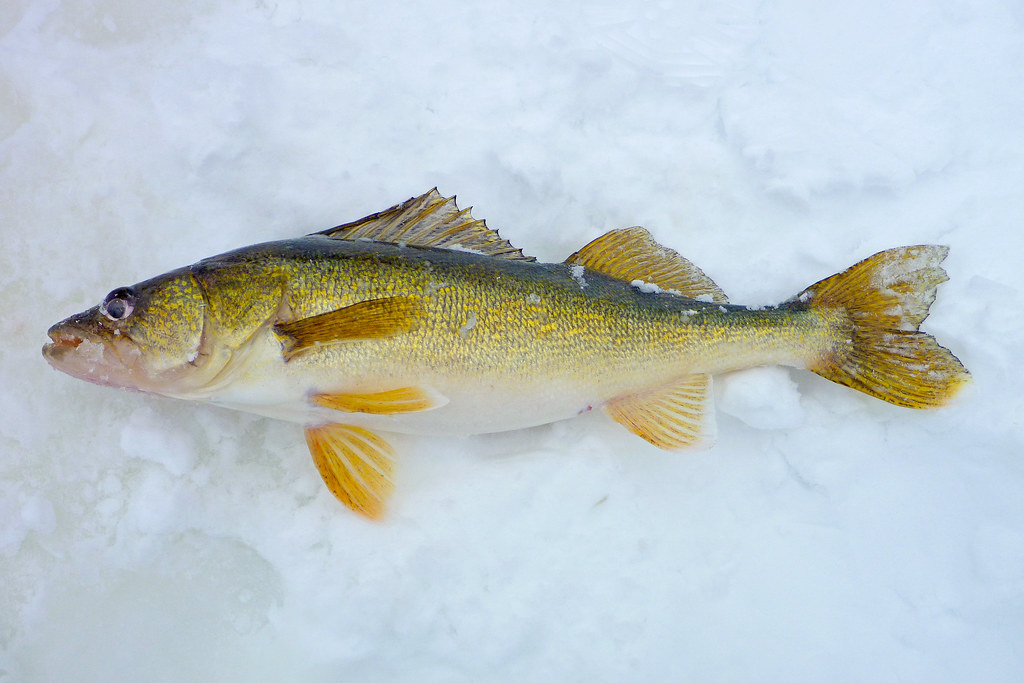Walleye
Sander vitreus
Walleyes are nocturnal top predators that feed on other fish. They are the largest member of the perch family and are not native to the Chesapeake Bay.
This section shows one large critter image at a time. Use the thumbnails that follow to select a specific image to display here.

This gallery contains a grid of small thumbnails. Selecting a thumbnail will change the main image in the preceding section.
Appearance
The walleye is the largest member of the perch family, growing to 30 inches and weighing 10-20 pounds. It’s back is dark or olive green with five to 12 narrow dark bands, light brownish yellow sides and a white belly. They have long, thin bodies and large mouths filled with sharp teeth.
Walleyes have two dorsal fins, an upper spiny one and lower soft-rayed one, as well as a white-tipped caudal fin and anal fin. The walleye is named after its large, pearlescent, opaque eye, which is caused by a reflective layer of pigment called the tapetum lucidum. This layer helps them see and feed at night, giving the walleye a sight advantage over other fish.
Feeding
Walleyes are nocturnal, feeding in shallow waters at night. Adult walleyes mainly eat other fish. Young walleyes eat small crustaceans and insects, primarily mayflies.
Predators
Adult walleyes do not have any natural predators in their habitat except humans, who catch and eat adult walleye. The eggs and young fish are susceptible to predation by other fish such as white bass, muskellunge, white perch, largemouth bass, northern pike and catfish. The young walleye avoid predation by staying near cover, where they can find places to hide from larger fish.
Reproduction and life cycle
Male walleyes reach sexual maturity in two to four years, and females reach sexual maturity in three to five years. Walleye spawning starts in the early spring, when water temperatures exceed 46 degrees Fahrenheit. Adult walleye will gather and spawn in gravelly shallows of tributary streams that flow into large reservoirs, or along the rocky face of dams within the reservoir, where there is a current to clear away sediment and aerate the eggs.
Females can deposit more than 100,000 eggs, which they deposit along the rocks and leave to develop without any parental care. The eggs are sticky and will stay attached to the rocks and gravel. After about two weeks, the eggs hatch and the young walleyes leave the spawning area to grow and develop. The average walleye lives about 10 years.
Did you know?
- The Maryland State Record walleye was captured in Jennings Randolph Lake, Garrett County in 1998. It measured 34 inches and weighed 14 pounds, four ounces.
- Walleyes are intentionally stocked for sportfishing. One of the earliest introductions occurred in 1874 when Livingston Stone gathered a small number of adult walleyes captured in Vermont and transported them to California where the fish were released into the Sacramento River.
Sources and additional information
- Maryland Fish Facts: Walleye — Maryland Department of Natural Resources
- NAS Nonindigenous Aquatic Species: Sander vitreus (Walleye) — U.S. Geological Survey
- Walleye (Sander vitreus) — Missouri Department of Conservation
- Walleye — National Wildlife Federation
- Walleye, Sander vitreus, (Mitchill. 1818) — U.S. Fish and Wildlife Service
- Sander vitreus, Walleye — Animal Diversity Web
